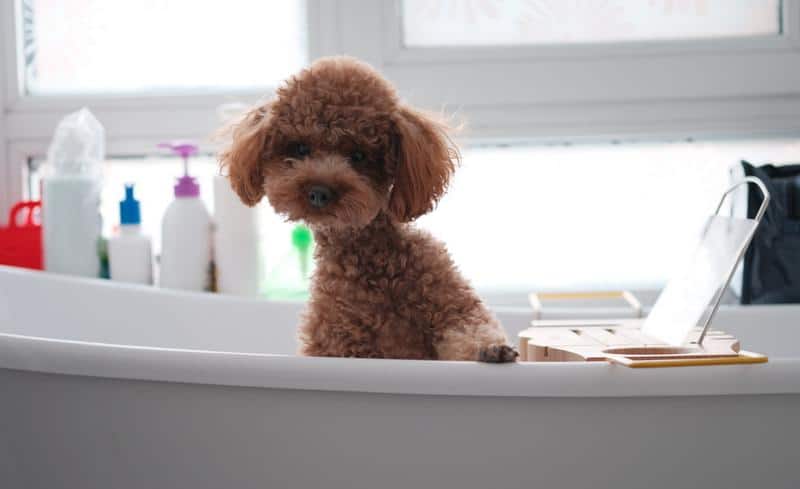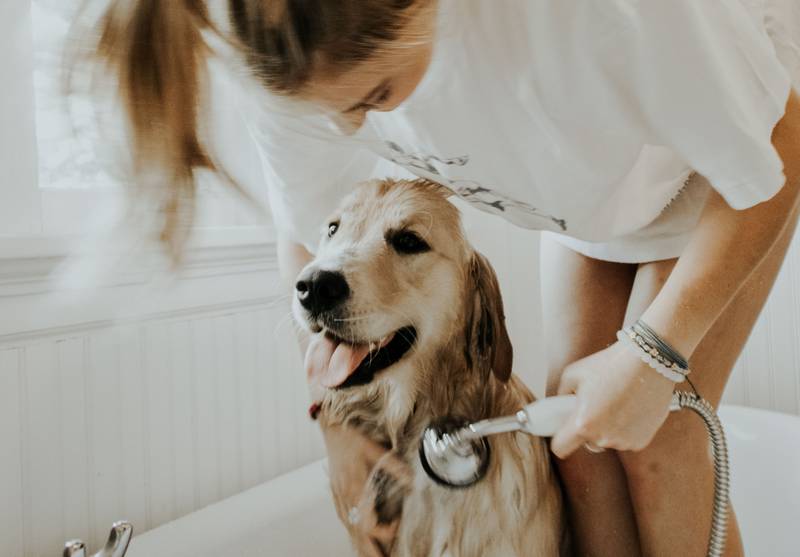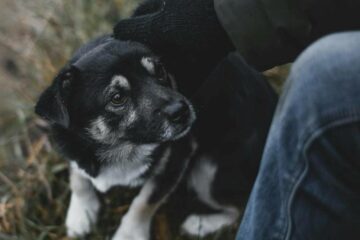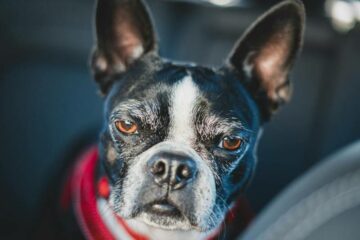Why Does My Dog Poop in the Bathtub? (+How to Stop!)
“Why does my dog poop in the bathtub?” If this is a question you’re tired of asking, we’re here to help. In this article, we’ll explore why your dog poops in the bathtub and provide helpful tips on how to stop them from going potty there or in the shower.
We’ve got all you need to know covered, from answering why your dog jumps in an empty bathtub, to dealing with issues of older dogs or puppies pooping in the shower or tub. And if you’re dealing with the mess left behind, we’ll even guide you on how to clean dog poop from the shower drain. Keep reading below!
Why Does My Dog Poop in the Bathtub?

Dogs poop in the bathtub due to reasons such as a change in their routine, stress, fear of the outdoors, or house-training issues. Addressing the issue often involves understanding the underlying cause and implementing appropriate solutions such as adjusting your dog’s routine, managing stress triggers, or re-establishing house-training.
- Change in Routine: Dogs are creatures of habit. A change in their routine, like a new work schedule for their owner or a change in their feeding times, can disrupt their usual bathroom schedule and lead them to seek alternative places to relieve themselves, such as the bathtub.
- Stress or Anxiety: Like humans, dogs can act out when they’re stressed or anxious. This could be a response to changes in their environment, such as moving to a new home, the arrival of a new family member, or loud noises like fireworks or thunderstorms. These anxiety-inducing situations might make your dog poop in the bathtub or other unusual places.
- Fear of the Outdoors: Some dogs develop a fear of going outside, often due to negative experiences like harsh weather or an encounter with an aggressive animal. If your dog is reluctant to go outside to relieve themselves, they might choose the bathtub as an alternative.
- House-Training Issues: If your dog isn’t fully house-trained, or if there’s been a lapse in their training, they might not understand that the bathtub isn’t an acceptable place to poop. In such cases, revisiting house-training methods may be necessary.
Identifying the reason why your dog is pooping in the bathtub is crucial in addressing this behavior. Patience, understanding, and positive reinforcement can go a long way in rectifying the situation. If the behavior persists, we’ve got the steps you need to prevent the behavior in the next section.
How to Stop Dog Pooping in Bathtub or Shower

To stop your dog from pooping in the bathtub or shower, ensure a consistent routine, manage their stress triggers, address any outdoor fears, and reinforce house-training. These solutions focus on altering the behavior and fostering better habits.
- Maintain a Consistent Routine: Regular feeding and bathroom schedules can help regulate your dog’s bowel movements. Ensure meals are given at consistent times each day, and provide plenty of opportunities for outdoor bathroom breaks. This consistency can prevent the need for your dog to seek alternative bathroom spots, like the bathtub or shower.
- Manage Stress Triggers: If your dog is pooping in unusual places due to stress or anxiety, identify and manage these triggers. This could mean providing a safe space during thunderstorms or fireworks, or slowly acclimating them to new changes in the home. Using positive reinforcement and providing comfort can also alleviate anxiety-driven behaviors.
- Address Outdoor Fears: If your dog has developed a fear of going outside, work gradually to make outdoor experiences positive again. Start with short, stress-free outings, gradually increasing the time spent outside. Offering treats and praise can reinforce positive associations with being outdoors.
- Reinforce House-Training: If your dog is choosing the bathtub or shower as a bathroom spot due to incomplete house-training, go back to basics. Make sure to praise and reward your dog for eliminating outside and clean indoor accidents thoroughly to remove the scent, reducing the likelihood of repeat incidents. If necessary, consider enlisting the help of a professional dog trainer.
But remember that while these steps will get your dog to stop pooping in the shower or bathtub, the underlying behavioral issue (anxiety, fear, etc.) that was causing all of this to begin with will still be present. And until you address that, any positive changes you see are only going to be temporary.
“Well, how do I make this change stick?”
By getting your dog to truly choose to follow your direction, that’s how. I tried many times to write out how you can do that before deciding it made more sense to just link you to the free video series that explains it better than I’d ever be able to.
The series is by a man named Dan who is one of the world’s leading dog obedience trainers. In it, he teaches you how to put an end to things like when your dog poops in the bathtub or shower and all other misbehavior using his fast and easy-to-follow methods.
In the first video, Dan will reveal to you why the two most common methods of dog training only doom you to failure. You can watch the video now by clicking here. Follow the proven system he’ll show you in his series and you’ll never have to spend another second worrying about your dog pooping in the bathtub or shower ever again!
Dog Jumps in Empty Bathtub: What’s Going On?
A dog jumping into an empty bathtub is usually due to curiosity, a desire for a cool place to rest, or an association with positive experiences like fun bath times. It could also be a sign of seeking attention if it’s followed by playful behaviors. It’s generally not a concern unless it’s accompanied by signs of stress or anxiety.
Curiosity
Dogs are naturally curious creatures. The bathtub, with its unique texture and cool surface, can be an intriguing place to explore. If your dog finds it enjoyable or interesting, they might jump in out of curiosity and make it a regular hangout spot.
Seeking a Cool Place
Bathtubs, particularly porcelain or enamel ones, can remain cool even when temperatures rise. If your dog is feeling hot, they might jump into the bathtub to cool down. This behavior is more common in warmer months or climates.
Positive Associations
If your dog associates the bathtub with pleasant experiences like fun baths or receiving treats, they might jump in hoping to recreate those positive times. This association can be reinforced if they continue to receive positive attention while in the bathtub.
Attention Seeking
Dogs sometimes perform unusual behaviors to get our attention. If your dog jumps into the bathtub and then engages in playful behaviors or looks at you expectantly, they might be seeking attention or playtime.
What to Do If Your Dog Keeps Jumping in the Bathtub
Unless the bathtub jumping is causing problems, it’s generally harmless behavior. If you’d rather your dog not go into the bathtub, discourage the behavior by gently guiding them out and redirecting them to a preferred activity or location. Positive reinforcement of good behavior can help this process.
Conclusion: Understanding Your Dog’s Unique Behaviors
While a dog jumping into an empty bathtub may seem unusual, it’s typically a harmless behavior driven by curiosity, comfort, or a desire for attention. To learn about addressing any underlying issues which may be causing disobedience from your dog, go back to end of the second section.
Older Dog Pooped in Bathtub: Why It Happens
An older dog pooping in the bathtub can be due to several reasons, including age-related incontinence, changes in bathroom habits, stress, or confusion. It’s important to address the issue promptly, taking into consideration the underlying cause and your dog’s overall health.
Age-Related Incontinence
As dogs age, they may struggle with incontinence, which is a loss of control over their bowel movements. This could lead to your dog having an accident in unexpected places like the bathtub.
Changes in Bathroom Habits
Older dogs may experience changes in their bathroom habits due to medical conditions such as arthritis that can make it painful to squat and poop outdoors. The bathtub might seem like a more comfortable option to them.
Stress or Anxiety
Stress or anxiety can cause dogs to have accidents in the house. Changes in the household, such as the addition of a new pet or a move, can cause stress and result in changes in bathroom behavior. For help on dealing with this scenario, go back to the second section now.
Confusion or Cognitive Dysfunction
Senior dogs can experience cognitive dysfunction, similar to Alzheimer’s in humans. This can result in confusion and changes in behavior, including forgetting house training rules.
How to Address This Behavior
If your older dog has started pooping in the bathtub, it’s important to consult with a vet to rule out any medical issues. Here are some strategies to manage this behavior:
- Ensure regular bathroom breaks: Older dogs often need to relieve themselves more frequently. Regular bathroom breaks can help manage incontinence.
- Make the outdoors more accessible: If mobility is an issue, consider using ramps or providing a comfortable, easy-to-access outdoor area for your dog to relieve themselves.
- Manage stress and anxiety: If stress or anxiety is causing the behavior, work on managing the stressors. This might involve behavioral training or consulting with a professional.
- Be patient and positive: Remember to be patient with your older dog. Positive reinforcement can go a long way in reinforcing good behavior.
Conclusion: Navigating Changes in Your Older Dog’s Behavior
Dealing with a senior dog pooping in the bathtub can be challenging, but understanding the potential causes can help you address the issue effectively. By consulting with a vet and providing a supportive environment for your older dog, you can help them navigate this stage of their life comfortably. As always, patience, understanding, and love are key.
Puppy Pooping in Shower or Tub
If your puppy is pooping in the shower or tub, it’s likely due to incomplete house-training, anxiety, or as a way to get attention. Ensuring regular bathroom breaks, providing comfort during stressful situations, reinforcing house-training, and maintaining a consistent daily routine can help in resolving this issue.
- Ensure Regular Bathroom Breaks: Puppies have small bladders and shorter bowel control, which means they require more frequent bathroom breaks. Ensure your puppy has ample opportunity to relieve themselves outdoors throughout the day, especially after meals, playtimes, and naps. Consistency in these routines will aid your puppy in understanding when and where they should be doing their business.
- Provide Comfort During Stressful Situations: Bathrooms can feel safe to a stressed puppy as they are quiet, enclosed spaces. If your puppy is anxious due to loud noises, unfamiliar environments, or separation, providing them with a comfortable, safe space can help alleviate their anxiety. Also, using positive reinforcement such as treats and praises during stressful situations can make them feel more secure.
- Reinforce House-Training: Your puppy may not be fully house-trained and might not understand that the shower or tub is not an appropriate place to poop. Use positive reinforcement to teach your puppy the correct place to eliminate. Immediately praise and treat your puppy when they relieve themselves outdoors to reinforce this behavior.
- Maintain a Consistent Daily Routine: Puppies thrive on routine. Regular feeding times, playtimes, and bathroom breaks can give your puppy a sense of security and aid in house-training. A predictable schedule will make it easier for your puppy to understand when it’s time to eat, play, and go to the bathroom.
Keep in mind, this is a relatively common issue in puppies and with consistency, patience, and positive reinforcement, your puppy can be house-trained successfully. If the issue persists, you should go back to the second section of this article, where we explain how to stop the behavior by also addressing the underlying cause.
Not treating the issue properly will only lead to the problem being even worse as your puppy develops into an adult. You’ll soon find your now adult dog pooping in the closet, pooping in your shoes, pooping on your bed, or pooping in the garage. I’m sure you can see why it’s important address things now, which you can learn to do in the second section.
How to Clean Dog Poop From Shower Drain
Cleaning dog poop from a shower drain requires a few steps including removing the solids, using an enzyme cleaner, flushing the drain, and disinfecting the area. By following a step-by-step process, you can ensure a thorough clean-up that eliminates any remaining waste and odor.
- Remove the Solids: Start by wearing gloves and using a plastic bag or a disposable scooper to remove as much of the solid waste as possible. Be careful not to push the waste further down the drain. Dispose of the bag or scooper appropriately in a sealed waste bin.
- Use an Enzyme Cleaner: After removing the solids, apply an enzyme-based drain cleaner. These cleaners are designed to break down organic matter like feces and can help to dissolve any remaining waste and tackle any associated odors. Be sure to follow the manufacturer’s instructions regarding use and safety precautions.
- Flush the Drain: After letting the enzyme cleaner sit for the recommended amount of time, rinse the drain thoroughly with warm water. This helps to wash away the broken down waste and the cleaner. Flushing the drain for a couple of minutes should suffice.
- Disinfect the Area: Once the drain has been flushed, it’s important to disinfect the shower and drain area to kill any lingering bacteria. A bathroom cleaner with disinfecting properties can be used for this purpose. Allow the cleaner to sit for the recommended time before rinsing thoroughly with water.
Following these steps should ensure a clean and odor-free shower drain. If you notice recurring issues with your dog defecating in the shower, go back to the second section of this article where we explained how to address both the problem and also its underlying cause.
I’m sure you’re ready to shower or use the bathtub without having to clean up dog poop first, so I’ll let you get started now. Good luck with everything, and thank you for reading our article “Why Does My Dog Poop in the Bathtub? (+How to Stop!)”.





